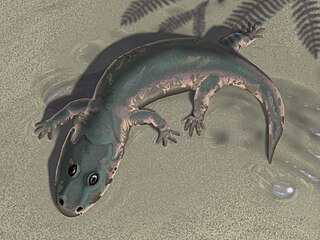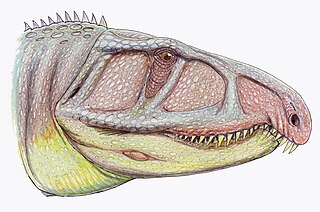Yimenosaurus is an extinct genus of plateosaurid sauropodomorph dinosaur that lived in China in the Early Jurassic. The genus was first named in 1990 by Ziqi Bai, Jie Yang and Guohui Wang, along with its type and only species, Yimenosaurus youngi. The species name honours renowned Chinese paleontologist Yang Zhongjian, the father of Chinese paleontology, known as C.C. Young in English. Known material includes the holotype, an almost complete skull and mandible, as well as incomplete cervical and dorsal vertebrae, a mostly complete sacrum, an ilium, ischia, partial ribs and complete femur, and a paratype, a well-preserved postcrania with a fragmentary skull. In 2010 Paul estimated its length at 9 metres (30 ft) and its weight at 2 tonnes.

Erythrosuchidae are a family of large basal archosauriform carnivores that lived from the later Early Triassic (Olenekian) to the early Middle Triassic (Anisian).

Erythrosuchus is an extinct genus of archosauriform reptiles from the Triassic of South Africa. Remains have been found from the Cynognathus Assemblage Zone of the Beaufort Group in the Karoo of South Africa.

Shansisuchus is an extinct genus of archosauriform reptile belonging to the family Erythrosuchidae that lived during the Middle Triassic in what is now China. The first fossils of Shansisuchus were discovered from the Ermaying Formation of Shanxi (Shansi) province in 1964 by Chinese paleontologist Yang Zhongjian. Like other erythrosuchids, Shansisuchus was a large-bodied carnivore with a large, deep skull. Shansisuchus is unique among early archosauriforms in having a hole in its skull called a subnarial fenestra.

Garjainia is an extinct genus of erythrosuchid archosauriform reptile from the Olenekian of Russia and South Africa. It was approximately 1.5–2 metres (4.9–6.6 ft) long. It contained two species, Garjainia prima from the Yarengian/Yarkenskian Supergorizont of Russia, and Garjainia madiba from the Burgersdorp Formation of South Africa. "Vjuskovia triplicostata", a name assigned to some erythrosuchid fossils from Russia, has been synonymized with Garjainia prima.

Doswellia is an extinct genus of archosauriform from the Late Triassic of North America. It is the most notable member of the family Doswelliidae, related to the proterochampsids. Doswellia was a low and heavily built carnivore which lived during the Carnian stage of the Late Triassic. It possesses many unusual features including a wide, flattened head with narrow jaws and a box-like rib cage surrounded by many rows of bony plates. The type species Doswellia kaltenbachi was named in 1980 from fossils found within the Vinita member of the Doswell Formation in Virginia. The formation, which is found in the Taylorsville Basin, is part of the larger Newark Supergroup. Doswellia is named after Doswell, the town from which much of the taxon's remains have been found. A second species, D. sixmilensis, was described in 2012 from the Bluewater Creek Formation of the Chinle Group in New Mexico; however, this species was subsequently transferred to a separate doswelliid genus, Rugarhynchos. Bonafide Doswellia kaltenbachi fossils are also known from the Chinle Formation of Arizona.

Tasmaniosaurus is an extinct genus of archosauromorph reptile known from the Knocklofty Formation of West Hobart, Tasmania, Australia. The type species is T. triassicus. This genus is notable not only due to being one of the most complete Australian Triassic reptiles known, but also due to being a very close relative of Archosauriformes. Once believed to be a proterosuchid, this taxon is now believed to have been intermediate between advanced non-archosauriform archosauromorphs such as Prolacerta, and basal archosauriforms such as Proterosuchus. Features traditionally used to define Archosauria and later Archosauriformes, such as the presence of an antorbital fenestra and serrated teeth, are now known to have evolved prior to those groups due to their presence in Tasmaniosaurus.

Kalisuchus was a genus of basal archosauriform known from remains unearthed from the Arcadia Formation of the Early Triassic of the Crater, Southwest of Rolleston, south central Queensland, Australia. It was named after Kali, the Hindu goddess of destruction, a reference to the very fragmentary nature of its remains. The type species of Kalisuchus is K. rewanensis, which refers to the Rewan Group. The Arcadia formation is dated to the Induan age at the very beginning of the Triassic, making Kalisuchus one of the oldest archosauromorphs known in Australia.

Cryobatrachus is an extinct genus of temnospondyl amphibian from the Early Triassic of Antarctica. The type species is Cryobatrachus kitchingi. It is known from a partial skull and an imprint of the skull roof, both found in the Fremouw Formation of the Transantarctic Mountains at about 85° south latitude and described in 1974. Many small bone fragments have also been identified, although they cannot be attributed with certainty to C. kitchingi. Cryobatrachus has been classified in the family Lydekkerinidae, as it is similar in appearance to the genus Lydekkerina from South Africa. Because only a small number of features distinguish it from other lydekkerinids, Cryobatrachus kitchingi has more recently been considered a nomen dubium, meaning that its distinction from other better-known species may be unwarranted.
Fenhosuchus is an extinct genus of archosauriform. The holotype, IVPP V 2697, and referred materials have been found in the Hsishihwa locality at Wuhsiang, China, from the Upper Ermaying Formation. The locality dates back to the Anisian stage of the Middle Triassic. The genus was named after the Fen River in Shanxi Province from which specimens were found. It may prove to be a chimera being composed of material from several different animals. Some material were believed to represent a rauisuchid. The calcaneum of Fenhosuchus seems to belong to an erythrosuchid or other basal archosauriform. Much of the material of the tarsal bones seem to be similar to those of the genus Shansisuchus. According to Nesbitt (2009) the assessment of Gower (2000) was correct, the holotype is a mix of Shansisuchus remains and a possible fragment from a paracrocodylomorph or a dinosauriform. Thus, Fenhosuchus cannot be considered a rauisuchian.
Fugusuchus is an extinct genus of archosauriform, probably the basal-most member of the family Erythrosuchidae. The genus is known from a single fossil from the middle Early Triassic Heshanggou Formation in Shanxi, China. The partial skeleton consists of an incomplete skull, parts of the right forelimb, and an intercentrum. The skeleton, known as GMB V 313, is currently in the Geological Museum of China in Beijing.

Yonghesuchus is an extinct genus of Late Triassic archosaur reptile. Remains have been found from the early Late Triassic Tongchuan Formation in Shanxi, China. It is named after Yonghe County, the county where fossils were found. Currently only one species, Y. sangbiensis, is known. The specific name refers to Sangbi Creek, as fossils were found in one of its banks.
Tsylmosuchus is an extinct genus of proterosuchid archosauriform reptile known from Western Russia. Fossils referred to Tsylmosuchus occurred over a wide area in sediments corresponding to the Induan and Olenekian stages of the Early Triassic. Most of these fossils are fragmentary neck vertebrae which were originally reported as sharing similarities with crocodile-line archosaurs (pseudosuchians) such as Mandasuchus. As a result, Tsylmosuchus was first described as part of the family Rauisuchidae, making it supposedly one of the oldest known archosaurs. However, its fragmentary remains do not show any of the distinguishing features of rauisuchids or even pseudosuchians in general, so Tsylmosuchus has more recently been interpreted as an indeterminate archosauriform. Although three species of Tsylmosuchus have been named, they lack diagnostic traits and are probably not distinct from each other. In 2023, Tsylmosuchus was reinterpreted as a proterosuchid, specifically a member of the subfamily Chasmatosuchinae.
Koilamasuchus is an extinct genus of indeterminate archosauriform from the Triassic of Argentina. It is based on an external mold of a partial postcranial skeleton from the Quebrada de los Fósiles Formation. Due to its incomplete nature, the relationships of this reptile are difficult to establish. Originally described as a non-archosaur archosauriform, later studies tentatively considered it a doswelliid or a suchian archosaur.

Youngosuchus is an extinct genus of archosaur from the Middle Triassic of China. The type species is Y. sinensis. Y. sinensis was first described in 1973 as a new species of the erythrosuchid Vjushkovia. In 1985, it was reassigned as its own genus of rauisuchid. A 1992 study supported the original classification of Youngosuchus sinensis as an erythrosuchid, but more recent studies classify it as a "rauisuchian"-grade loricatan archosaur completely unrelated to Vjushkovia, which is most likely a synonym of Garjainia.
Mesodapedon is an extinct genus of hyperodapedontid rhynchosaur from middle Triassic deposits of India. It is known from the holotype ISIR-300 and from the paratype ISIR-301 from the Yerrapalli Formation. It was first named by Sankar Chatterjee in 1980 and the type species is Mesodapedon kuttyi. It is extremely closely related to the Tanzanian Stenaulorhynchus and even was considered to be its synonym.
Guchengosuchus is an extinct genus of erythrosuchid archosauriform from the Early Triassic of China. It is known from a single holotype skeleton called IVPP V 8808, described in 1991 from the lower Ermaying Formation in Shanxi. The lower Ermaying Formation dates back to the Olenekian stage of the Early Triassic, making Guchengosuchus one of the earliest archosauriforms. IVPP V 8808 is a disarticulated skeleton including a partial skull, lower jaw, some vertebrae, a scapula, and forelimb bones. Like some other erythrosuchids, Guchengosuchus has a tall skull with a notch between the premaxilla and maxilla bones of the upper jaw. The ribs of Guchengosuchus each have three heads, a feature also seen in the Russian erythrosuchid Vjushkovia. When it was first described, Guchengosuchus was placed in the suborder Proterosuchia, a group that included the families Erythrosuchidae, Proterosuchidae, and Proterochampsidae and was thought to be closely related to a primitive group of reptiles called Eosuchia. Proterosuchia is now considered a paraphyletic assemblage of basal archosauriforms representing a series of successive branches of stem group archosaurs.

Uralosaurus is an extinct genus of erythrosuchid archosauriform known from the Middle Triassic Donguz Formation of southeastern European Russia. It contains a single species, Uralosaurus magnus. It was named by Vitalii Georgievich Ochev in 1980 as a species of Erythrosuchus otherwise known from the Triassic of Africa and reassigned to its own genus by Andrey G. Sennikov in 1995.

Polymorphodon is an extinct genus of archosauriform reptile from the Middle Triassic of Germany. The only known species is Polymorphodon adorfi, discovered in Lower Keuper deposits at a quarry in Eschenau, Germany. Polymorphodon is notable for its heterodont dentition, with long and conical premaxillary teeth followed by thin maxillary teeth with large serrations. Maxillary teeth near the back of the mouth are short and leaf-shaped, similar to some living and extinct reptiles with a herbivorous or omnivorous diet. This may suggest that Polymorphodon had some reliance on plants in its diet, a rarity among basal archosauriforms, most of which are carnivores.
Syntomiprosopus is an extinct genus of archosauriform, possibly a crocodylomorph from the Late Triassic period of Arizona. The type and only known species is S. sucherorum. Syntomiprosopus was unusually short-snouted, comparable to the Late Cretaceous notosuchian Simosuchus, and is regarded as an example of convergent evolution between Triassic stem-archosaurs and Cretaceous archosaurs.













